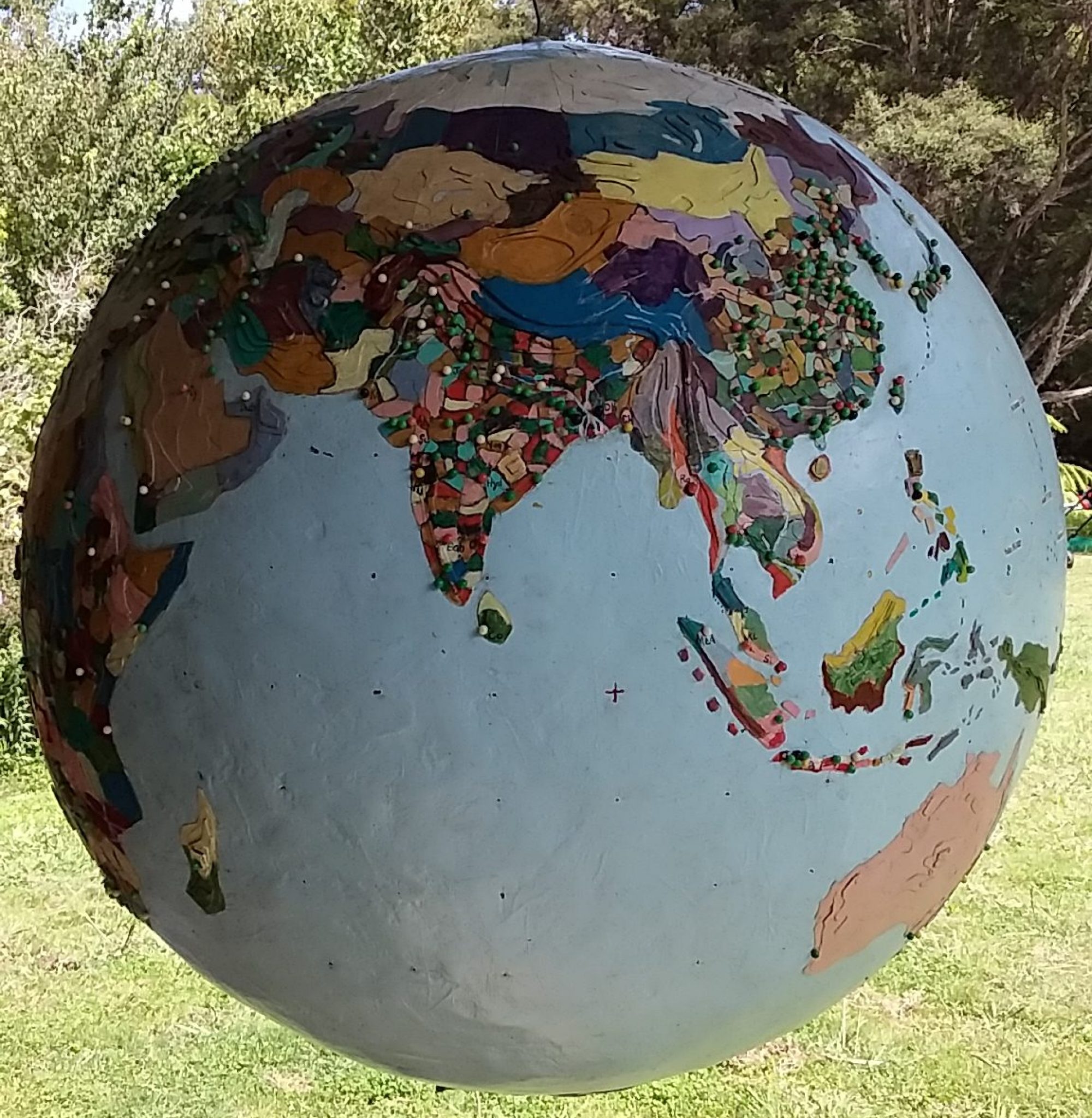The watershed flowing west into the Murray/Darling river system, which is often dry when it discharges into the Great Australian Bight near Adelaide (population 1.3 million) and the rest of Australia all the way to Perth (population 2 million) on the west coast, are needed to form the millisphere of OZ.
In 1997, I first saw OZ looking west from the Blue Mountains, a days train ride from Sydney. Another day on a bus heading inland and we were still just on the edge of OZ. Scrubby plains curved off over the horizon.
At Bathurst, “the objective and terminal point of the only inland journey made by Charles Darwin in Australia in January 1836”, I sketched Eucalyptus leaves and seeds used as a motif on a cast iron verandah pole at the railway station, now servicing mainly buses.
Bathurst is where Sydney artist Brett Whiteley’s was sent to boarding school but it’s better known for its race track, where the annual Holden/Ford high performance production car race was held (the Australian Holden finished production in 2017). A Bathurst farmer was going to drive to Sydney; when asked which route he was going to take, replied “I think I’ll take the wife”. That was an Aussie joke! After Sydney, Bathurst had noticeably fewer “immigrants,” meaning the non-British stock who had come after Australia’s “whites only” immigration policy ended in 1973.
On the bus, before changing at Cootamundra for Canberra, we passed through Gundagai, immortalised in one of Banjo Paterson’s poems. “Branching off there runs a track, across the foothills grim and black, across the plains and ranges grey to Sydney City far away. … The tracks are clear she made reply, this goes down to Sydney Town and that one goes to Gundagai.” Following a beautiful woman to Sydney in Paterson’s poem is a metaphor for the attraction of the big city. The Sydney and Melbourne metropolitan areas combined have around a half of all Australia’s population.
 “Though I’ve covered many roads in my lifetime, I just can’t wait to see what the next road will bring,” sang Slim Dusty, evoking long distance rides and wanderlust. With Slim on the CD of the hired silver Holden Commodore we headed to the Murray River, flowing sluggishly flowing through OZ.
“Though I’ve covered many roads in my lifetime, I just can’t wait to see what the next road will bring,” sang Slim Dusty, evoking long distance rides and wanderlust. With Slim on the CD of the hired silver Holden Commodore we headed to the Murray River, flowing sluggishly flowing through OZ.
Dusty merino sheep grazed dry paddocks. When we found the river we made our way through dry gum forest, bare underneath apart from a carpet of gum bark. We kept an eye out for snakes. Compared with lush New Zealand it seemed very dry.
Australia was in the lead up to “the big dry”, the 1996-2010 “millennium drought” caused by lower rainfall and higher temperatures. The ecology of the Murray/Darling river basin (population 2 million), which drains one seventh of Australia’s land mass, was, by all accounts, already in poor health.
In 1938 Aborigine William Cooper petitioned the Nazi German embassy in Melbourne against the Kristallnacht and the treatment of Jews in Germany; his people knew about genocide. When the British set up the first penal colonies on the coast there were around one million aboriginals in Australia a century later it had dropped by 80% to 200,000 (It’s now 400,000).
In pre-British times the Murray/Darling wetlands were a huge source of food for Aborigines. Historically the white man (and woman) pushed the Australian Aborigine off the best land and into the desert.
There are still Aborigine communities in the Murray/Darling and their needs are listed as a matter of course in management plans aimed at bringing the rivers and wetlands back to health.
 There has been much resistance from irrigators against any move to return “environmental water” to the river, but it is generally accepted that since the 1970s, when increasing amounts of water was taken for irrigation, the river has ceased to flow more often and for longer periods. The reality is that at the river mouth has to continuously dredged because the river flow is not great enough to discharge the sand into the sea.
There has been much resistance from irrigators against any move to return “environmental water” to the river, but it is generally accepted that since the 1970s, when increasing amounts of water was taken for irrigation, the river has ceased to flow more often and for longer periods. The reality is that at the river mouth has to continuously dredged because the river flow is not great enough to discharge the sand into the sea.
One problem is the rivers flow through four states, a problem that the establishment of the Murray/Darling Basin Authority (MDBA) was meant to overcome, and periodically states threaten to leave the MDBA.
“A four billion dollar (Australian) waste of taxpayer money,” is one assessment of the MDBA’s work so far.



